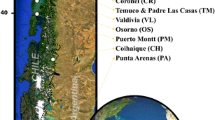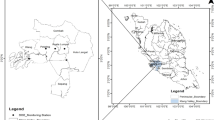Abstract
This study examined the spatial distribution of particulate air pollution in the Warri metropolis. This was done to ascertain the differences between the distribution of particulate matter (PM10) in the urban area and the surrounding rural areas. To achieve this, the study generated data from field measurement of PM10 levels for the year 2003. Analysis of variance, the U-test, and simple regression statistical techniques were used to analyze the data. The major finding of the study was that the Warri metropolitan area is polluted with PM10 levels of over 126 μg/m3, which is 81% over the 70 μg/m3 threshold of the World Health Organization. However the built-up area of the Warri metropolis is 150% more polluted with PM10 particulates than the surrounding rural areas. While the traffic-clogged area of Enerhen, Jakpa, Deco, and Estate Junctions are the most polluted areas with levels of 151 μg/m3, traditional areas had the lowest levels of 128 μg/m3. The daily distribution of PM10 showed that Mondays were the most polluted days with levels of 145 μg/m3 and Fridays were the least polluted days with levels of 141.5 μg/m3 in the built-up area, whereas in the rural area Wednesdays were the most polluted days with levels of 57.1 μg/m3 and Sundays were the least polluted days with levels of 53.5 μg/m3. Mondays generally recorded the highest PM10 values because of the large amount of industrial operation, heavy vehicular traffic in the peak period, and increased commercial activities. The study also showed significant variation in the level of PM10 particulates within the urban areas of the Warri metropolis with a calculated F-value (3.29), which is greater than the critical F-value of 3.14 at the 0.05 significance level. It is therefore recommended that urban environmental management policy should be vigorously pursued to curb the adverse consequences of increased PM10 levels in urban areas of the Warri metropolis.





Similar content being viewed by others
References
Akanki EO (1990) Air pollution control. In: Omotola JA (ed) Environmental law. Lagos faculty of Law, University of Lagos, pp 5–50
Ayoade JO (1994) Human impact on the environment. In: Filani MO, Akintola FO, Ikporikpo CO (eds) Ibadan region. Ibadan Rex Charles Publisher, pp 222–229
Bluman AG (1995) Elementary statistics. A step-by-step approach. W. C. Brown publisher, Chicago
Botkin DB, Keller EA (1998) Environmental science. Earth as a living plane, 2nd edn. Wiley, New York
Charlson RJ, Schwartze SE, Hales JM, Cess RD, Coakley JA, Hansen JE, Hofmann JO (1992) Climate forcing by anthropogenic aerosols. Science 255:430
Davidson S, Passmore R, Brock JF, Truswell AS (1975) Human nutrition and daletics, 6th edn. Longman, Britain
Douglas D (1996) Health effects of acid aerosols on North American children respiratory symptoms. Env Health Perspect 104(5):503
Ebdon D (1977) Statistical for geography: a practical approach. Basil Black, Oxford
Efe SI (2002) Urban warming in Nigeria cities. The case of Warri metropolis. Afr J Environ Stud 3(1–2):160–168
Efe SI (2005) Urban effects on precipitation amount, distribution and rainwater quality in Warri metropolis. PhD Thesis, Department of Geography and Regional Planning Delta State University Abraka, Nigeria
Karl TR (1991) Global warming evidence for asymmetric diurnal temperature change. Geogr Res Lett 18:2253–2256
Kerr RA (1992) Study unveils climate cooling caused by pollutant haze. Science 268:802
Microsoft Encarta Encyclopedia (2001) Air pollution. Microsoft Corporation
Okecha SA (2000) Pollution and conservation of Nigeria environment. Ekpoma, T’ Afriqu inter ass. W. A.
Okoye ND, Schouten D, O’ Sullivan AJ (1987) Monitoring and evaluation of oil related pollution in NNPC operation. Proceeding of the seminar on petroleum industry and Nigeria environment. Held in Imo Concord hotel, Owerri
Oriero SB (1998) The spatial pattern of domestic sewage disposal in Warri metropolis. PhD Thesis, Department of Geography and Regional Planning, University of Benin, Nigeria, pp 37–39
Shprentze D (1996) Breathtaking; premature mortality due to particulate air pollution in 239 American cities. New York National Defense Council, pp 14–15
Union of Concern Scientist (UCS) (1989) The greenhouse effect. Cambridge, MA
World Health Organization (WHO) (1994) Update and revision of the air quality guidelines for Europe. WHO regional office for Europe. No.EUR/ICP/EHAZ 94–05/PB01, Copenhagen
WHO (2001) Update and revision of the air quality. Microsoft Corporation. Copenhagen
Author information
Authors and Affiliations
Corresponding author
Rights and permissions
About this article
Cite this article
Efe, S.I., Efe, A.T. Spatial distribution of particulate matter (PM10) in Warri metropolis, Nigeria. Environmentalist 28, 385–394 (2008). https://doi.org/10.1007/s10669-007-9154-0
Received:
Accepted:
Published:
Issue Date:
DOI: https://doi.org/10.1007/s10669-007-9154-0




